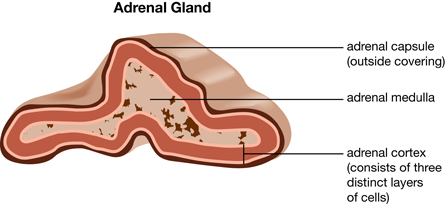Module 2
1. Module 2
1.21. Page 2
Module 2—The Endocrine System
 Explore
Explore
Adrenal Gland and Stress Reactions
 Read
Read

© Vladimir Mucibabic/shutterstock
If you look at “Figure 13.19(B)” on page 451 of the textbook, you will see that the adrenal glands look like small baseball caps perched on top of the kidneys. Further examination shows that each adrenal gland is really two glands with the adrenal cortex (meaning “bark”) wrapped around the adrenal medulla (meaning “middle”). The adrenal cortex consists of layers of secretory cells, whereas the adrenal medulla consists of modified nerve cells. What other gland have you studied that is made of both nervous and endocrine tissue? If you answered, “the pituitary gland,” you are correct. Both parts of the adrenal gland produce and release hormones in response to stress stimuli.
In the Student Stress lab that you completed in Lesson 1, you created a stressful situation for your partner. The adrenal gland would have played a significant role in bringing about changes in your partner’s blood pressure and heart rate. The stress reactions of the human body comprise a wide range of reactions that prepare the body to resist any damaging or potentially damaging changes in the environment. A great variety of stimuli trigger these responses, including injury, infection, and emotional responses, such as fear or anger. The effectiveness of a particular stimulus varies from person to person. You may be freaking out about that exam in the afternoon, but your friend may not be worried about it at all. Or the bass in your car stereo may be driving your parents nuts, but you’re enjoying the beat.
adrenal cortex: the outer portion of the adrenal gland composed of three distinct layers of cells that respond to hormonal signals from the anterior pituitary by producing three groups of hormones, including the glucocorticoids, mineral corticoids, and gonadocorticoids; reacts to stress stimuli and affects salt and water balance
adrenal medulla: the central or middle part of the adrenal gland composed of modified nervous tissue that responds to sympathetic nerve signals by secreting the fight-or-flight hormones, epinephrine and norepinephrine, in reaction to stress
For an introduction to the adrenal glands, read page 451 in your textbook.

 Watch and Listen
Watch and Listen
Review and reinforce concepts about the adrenal gland and stress responses by viewing the following two segments of “The Adrenal Glands and the Gonads: Stress and Sexuality: Vital to Life.” You may be required to enter a username and password to access these videos. Contact your teacher for this information.
- “Adrenal Glands”
- “Bio Review: Adrenal Glands and Stress”